Urban Design
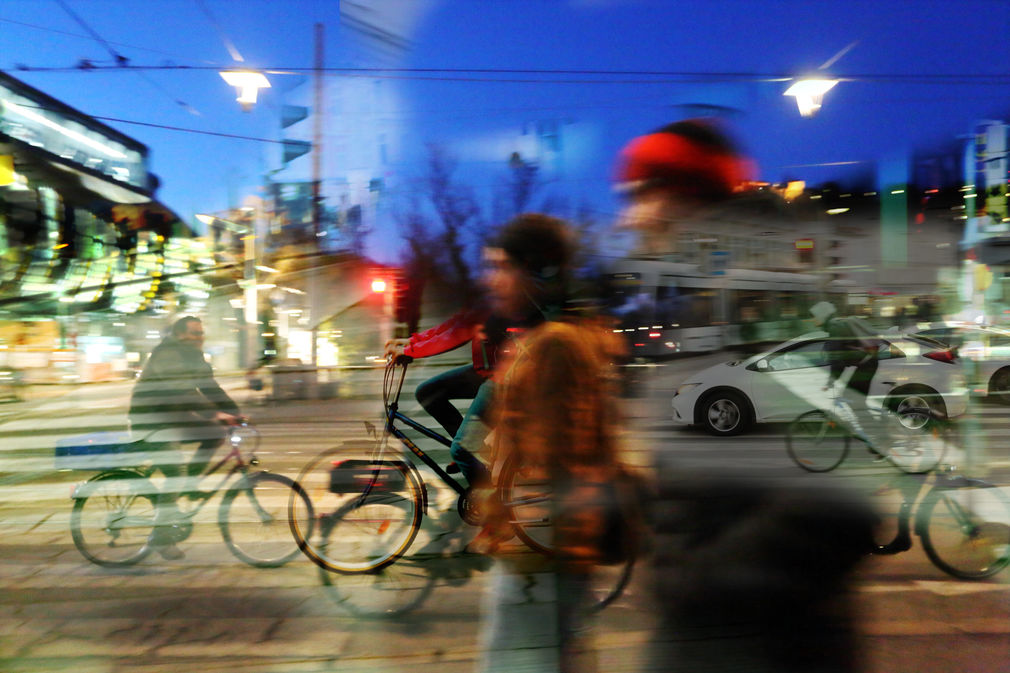
Mobile Graz
Photo: Max Wegscheidler
-
Prof. Dr. Kai Vöckler
T
Cube
-
Dipl.-Des. Annika Storch
Function
Research Associate
T +49 (0)69.800 59-313
Cube
Student assistant
Emelie Trenkler
Publications
Downloads
- Urban_Design_VR-Lab_Luisenplatz_WiSe2021-22_booklet_web-komprimiert.pdf
- Urban_Design_OFBlock_Booklet_Juli2022_low-res.pdf
- BewegDeinQuartier_HfGOF_2021_web.pdf
- Making Mobility Visible
- 02_Vairplay_Dokumentation_Website.pdf
- Theater_der_Welt_documentation_2023.pdf
- OFHBF_Upgrade_Dokumentation_Druckbögen_kompr_2024.pdf
- Marktbazaarsuqetc_booklet_2025.pdf
Institutes
OIMD – Offenbach Institute of Mobility Design
Research projects
-
BMBF TraFoDes (2025–2028)
-
LOEWE research cluster Infrastructure –Design– Society (2018-2022)
- HMWEVW Sustainable mobility in subsidized housing construction (2019–2021)
- HOLM CogDes (2019–2020)
- BMBF InterMoDe I (2019–2021)
- HOLM EmotDes (2021-2022)
- HOLM AI Lab Trust (2021–2022)
- BMBF InterMoDe II (2021–2024)
-
DZSF Station of the Future (2022-2025)
-
HOLM VisKom (2023–2024)
-
BMBF InterMoDe III (2024–2026)
Doctoral candidates
Ruth Duma-Coman
Improvisation, Urban Design and Migration
Supervisors: Prof. Dr. Kai Vöckler, Prof. Heiner Blum
Julian Schwarze
Product Semantics and Mobility
Supervisors: Prof. Dr. Kai Vöckler, Prof. Peter Eckart
Urban Design
Urban design focuses on designing processes in space. It looks at the interaction between acting people and objects, information and the indoor/outdoor spaces that surround them, along with extensions to the latter in the form of digitized, virtual environments. Human-centered spatial design is systemic and draws on a number of different disciplines, while the teaching uses various methods to analyze and research design and architecture. Findings from perception and environmental psychology as well as cognitive science are taken into account, as is research from the social and behavioral sciences, and are incorporated for clarification of the design task. The aim is to design spaces that facilitate access for users, positively influence their experiences, and support the formation of spatial identity. The theory of product language developed at HfG Offenbach is incorporated here and expanded to include the ecological approach.
Teaching
Spatial Design I (Perception and Space)
In the perception of spatial environments, formal-aesthetic aspects of structuring play an important role: How are objects and information positioned? How is the surrounding space structured? How are they experienced in movement, in an active, exploratory perception? How does design help to foster the legibility of the spaces (orientation) and to cultivate a positive feeling (self-location)? The focus is on the perception of spatial structure, and an overview is given of the design-related influencing factors, whereby the relationship between human and space takes center stage.
Spatial Design II (Action and Space)
In the use of objects and spaces, learned and unconsciously exercised bodily techniques play a key role. How, in design terms, can the immediate “handling” of space-forming objects be made easier? How can intuitive access and thus a direct and trouble-free use of spaces be achieved? The design of offerings in the form of action-related informations (indicating signs/affordances) is coupled with information in the form of communication: pictorial and written signs that serve for orientation and understanding and which expand the information space on a digital basis. Action-related and communication-based information helps to structure and divide up spaces, while design decisions make access and usage, legibility and self-orientation easier and better. The focus here is on the interaction with objects and information in the movement within the space.
Spatial Design III (Process and Space)
The movement of people within spaces takes shape in dynamic sequences of interactions, the complexity of which poses a particular challenge for design. Be it on foot, by bicycle, alone or with others in a train, bus or car: on pavements and roads, in buildings or in squares, or even in transitional places such as railway stations – how can design decisions positively influence behavior and perceptions in these very different spaces in a process of movement? On top of this, aside from the functional influencing factors (access, usability, recognizability and legibility, orientation), the socio-economic factors (quality of time and experience in the space, subjective safety, privacy and sociality, self-determination) must also be taken into account in the design in order to facilitate unhindered access and to formulate a spatial offering that forges identity. With the increasing overlapping of the physical, analog space with algorithmic environments, the digitally based expansion of the information and communication space must also be taken into account. This expands the task of design to include environmental design and thus a conceptually and systematically oriented design approach.
Research Focus on Mobility
Driving is becoming less and less fun: Commutes are ever busier, traffic jams ever longer, and finding a parking space ever more tortuous… But this is about to change, because we are on the verge of a qualitative shift in the way we move around. With digital availability (mobile internet via smartphone), new and intelligent forms of mobility are becoming possible: In the future, we will be able to easily configure different modes of transport according to our needs (networked and multimodal mobility). The smooth and secure transition from one form of mobility to another and thus the use of different modes of transport on one route could be direct and flexible in future (intermodal mobility). This simplifies the use of public as well as communal forms of transport (sharing). My journey requirements and preferences are things I will decide directly and however I want. Facilitating this new freedom of mobility requires not only a problem-free interaction of the different mobility offerings and modes of transport, but also a comprehensive design of the mobility spaces in which the users move, including in mobile use of the internet. This concerns not only the functional-practical correlations, but essentially also the emotional factors: Do I feel comfortable? Do I feel safe? It is the needs of the different users that must be taken into account in the design of the new, environmentally friendly mobility offerings. This is where design research at HfG Offenbach comes in.
This must be considered against the background of economy and society within the Rhine-Main region, which are essentially determined by processes and systems of mobility. Climate change and scarcity of resources, but also the steadily increasing volume of traffic increase the urgency with which researchers all over the world are trying to find new solutions for mobility in urban areas. Accordingly, one of the future tasks of design will be the development of innovative methods and specific tools and strategies to positively promote sustainable, future-proof projects in the field of mobility, to make them more efficient and more visible, and thus to boost acceptance among the population. Scientific areas of action such as traffic planning, mobility research in relation to social science, cognitive psychology, architecture and communication technology are combined with design research on the topic of mobility within the research focus.
The Design Institute for Mobility and Logistics (DML) located at the department is dedicated to these topics and their scientific exploration. Its initiators are Prof. Peter Eckart, Prof. Georg-Christof Bertsch and Prof. Dr. Kai Vöckler. Numerous research projects have been carried out within this thematic area since 2014.
Projects
Marktbazarsuqetc.
A new place for Offenbach in the inner courtyard of the former post office building on Aliceplatz
The marktbazarsuqetc. seminar takes up the challenge of creating a new place – of commerce, culture and social life – for Offenbach’s city center; a place that stands for Offenbach with its diverse population. In a globalized world, cultural diversity is a key resource for urban life and social cohesion. Migrant communities in particular contribute significantly to the cultural, economic and social dynamics of cities. In order to make this diversity visible and actively promote it, innovative approaches were developed in collaboration with VAIR e.V. to design a new type of hybrid “bazaar” that represents the diversity in Offenbach and transforms the approach to the exchange of goods, ideas and cultures in a contemporary way.
Participants
Ole Achenbach, Marie Bauer, Ron Behringer, Renata Dzhakh-Dzhakh, Moritz Gauss, Franziska Herbert, Emil Kirchgessner, Lotte Landgraf, Elise Olenina, Eleonora Schilling, Jan Schneider, David Schönfeld, Mignon Vahl, Iana Vydrina, Daniel Wolff-Franke
Supervisors
Prof. Johanna Siebein, Prof. Dr. Kai Vöckler, Dipl.-Des. Annika Storch, Dipl.-Des. Maziar Rastegar
Cooperation
VAIR e.V.
Year
Wintersemester 2024-2025
Download
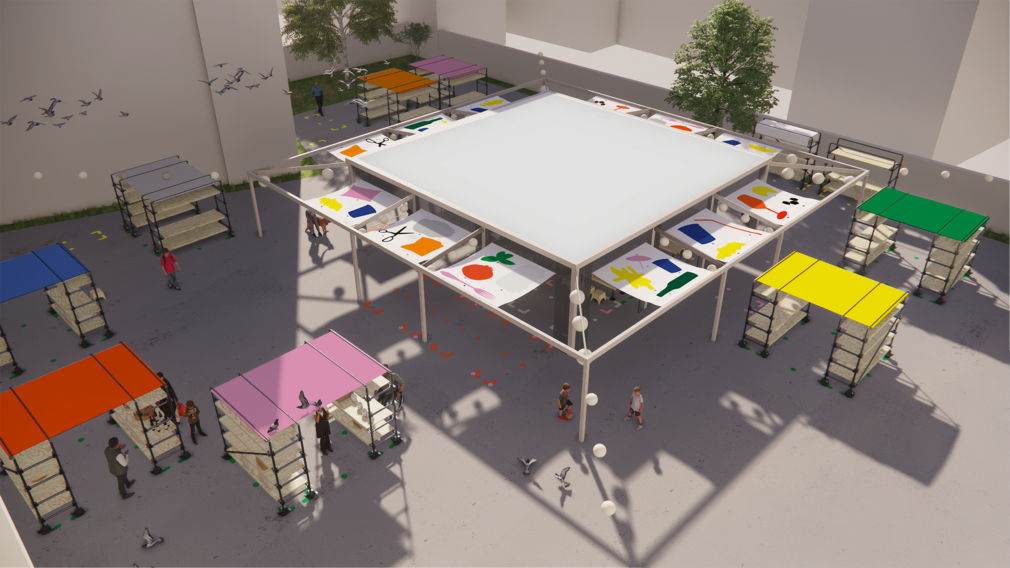
Offenbach Hauptbahnhof: Upgrade!
Offenbach's main railway station was once a prestigious and exquisitely designed gateway to the city. Over the years, however, it has lost its central importance and attractiveness. With the expansion of the S-Bahn at the end of the 1990s, the main station lost its key position in local and long-distance transportation to the stations in Hanau and Frankfurt. Today, Offenbach's main station is in a largely neglected state. With the increasing importance of environmentally friendly mobility, especially in rail and bus transportation, Offenbach's main station is facing new challenges and opportunities. In future, it will assume an important linking function alongside the Offenbach-Marktplatz and Offenbach-Ost S-Bahn stations. It is no longer just a question of handling trains, but of developing the station into a multimodal mobility platform. This means seamless use of mobility services by combining rail transport with other mobility services such as walking and cycling, buses, cabs and various sharing services. The focus of the seminar was not only on the building itself, but above all on the area surrounding the station. This included the central bus station (ZOB), the car-sharing services and the cab rank. Special emphasis was placed on the link with pedestrian and cycle traffic, including the pedestrian and cycle tunnel and the Bismarckstraße underpass.
Supervisors
Prof. Dr. Kai Vöckler
Dipl. Des. Annika Storch
Year
Winter semester 2023-24

Theater der Welt 2023
For 44 years „Theater der Welt“ has been the largest international theatre festival in Germany. It has been organized by the German „International Theatre Institute“ (ITI). Every second year it is hosted by an alternate city with different theatres under varying directorships. In the summer of 2023, it took place in Frankfurt and Offenbach hosted by the Theater Mousonturm. The program director, Chiaki Soma from Tokyo, was surprisingly the first ever non-European curator of this festival. The necessity to dissolve the dominant eurocentric perspectives is as plain as day. Therefore, Chiaki Soma proposed renaming the festival to more reflect a global performance culture: „Theater der Welten“ (Theatre of the Worlds). A space for encounters between two cities, where the role of performative arts in post-pandemic times of global conflicts can be reflected upon. Chiaki Soma believes in a time for reflection, a space for innovation, theatre as the practice of healing and tending, the spreading of a good virus, the bridging of various worlds, generating new perspectives and using one’s own bodie to give warmth to some new form of life which has not yet been encountered. We were invited to participate in this festival, to look for it.
Participants HfG Design / Art
Felix Adam, Danja Bader, Francesca Bagini, Luis Benz, Hannah Borghese, Paul Böttcher, Ai Vi Bui, Julian Glunde, Paul Groß, Ano Jiskariani, Marta Kamienska, Jana Köhle, Maeng Seungyeon, Yujin Park, Josephine Pavesi, Emelie Christina Trenkler, Marlon Vargas
Supervisor
Prof. Dr. Kai Vöckler
Cooperation
Theater der Welt / Mousonturm Frankfurt
Prof. Benjamin Förster-Baldenius, Cohabitation Lab, Städelschule Frankfurt
Prof. Heike Schuppelius, Stage Design, HfG Offenbach
Year
Summer semester 2023
›VAIRPLAY‹. A sports and cultural park under the Kaiserlei Bridge.
Under the project name VAIRPLAY, the non-profit association VAIR e.V. wants to develop a public space that is intended to facilitate more community. An inclusive sports park is to be created under the Kaiserlei Bridge, below the A 661 motorway: The first public sports and culture park in Offenbach! A place for more togetherness, a space for sports activities as well as for recreation, but also for cultural events. The goal is to connect people through sports, exercise and culture.
Sports parks are not only places for physical activities or social exchange, but also a visual attraction - especially the tricks of the skaters fascinate many people. VAIR e. V. has asked the HfG Offenbach/the Urban Design teaching area to develop a concept for this sports and culture park with the students and to make drafts. The goal is to show how an innovatively designed public space can be created under a highway bridge.
Participants
Ron Behringer, Buddhas Braun, Jannis Eickert, Till Eser, Sophie Körbler, Emma Kottwitz, Amelie Mattas, Felix Muszinski, David Wellen, Daniel Wolff-Franke
Supervisors
Prof. Dr. Kai Vöckler
Dipl. Des. Annika Storch
Dipl. Des. Maziar Rastegar
Cooperation
VAIR e.V.
Year
Summer semester 2023
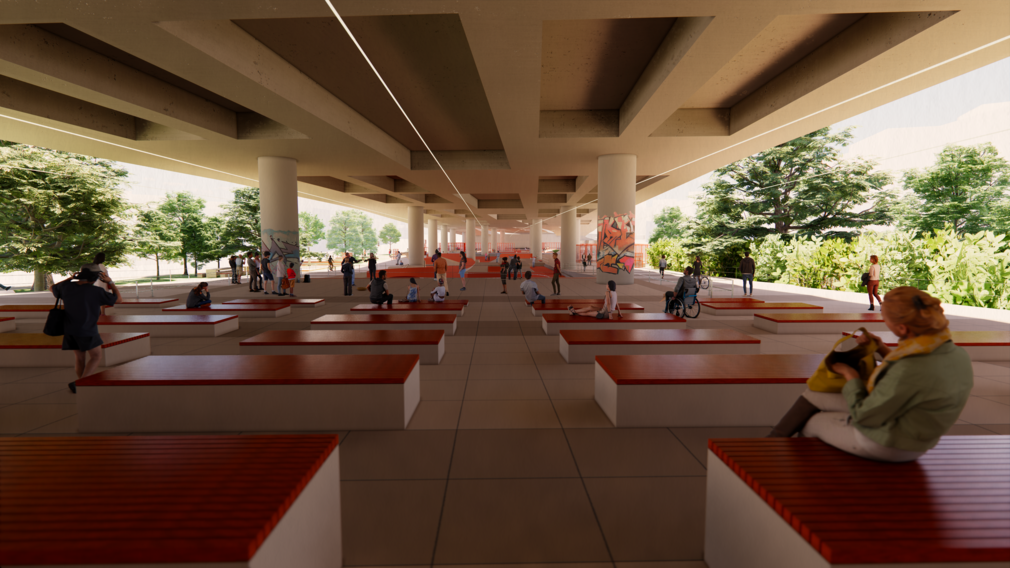
<Staging> Theatre of the World
The international festival "Theatre of the World" will be a guest in Frankfurt and Offenbach in the summer of 2023. The programme director Chiaki Soma with Kyoko Iwaki from the collective "Arts Commons Tokyo" are the first curators for "Theatre of the World" who are not from Europe. With their programme concept, they question the existing norms of the
Western art and culture business in many ways. Some of the world's most important representatives of the international performance and theatre scene are invited to make this the subject of their work. The international theatre works are to be brought into dialogue with the diverse local urban societies as well as with the glocal communities, which are at the same time locally and internationally networked.
In a first step, students from the departments of art and design developed ideas, concepts and designs in the winter semester that deal with the requirements for temporary and mobile platforms that "dock" with the theater productions and locations (in indoor as well as outdoor spaces) and that enable a social exchange on site. In this way, the concrete site with its residents and the international theater world are to be put into relation. The spatial interface between these two worlds is to be designed accordingly. At the same time, the design should also create a connection between the different venues, making them recognizable as part of the festival.
Participants
Felix Adam, Afonso Santos, Ai Vi Bui, Noa Haller, Yujin Park, Johann Rambow, Julia Schütze, Anna Sivaglieri, Emelie Trenkler, Marlon Wilde
Supervisors
Prof. Dr. Kai Vöckler
Dipl. Des. Annika Storch
Cooperation
Theater der Welt / Mousonturm Frankfurt
Prof. Benjamin Förster-Baldenius, Cohabitation, Städelschule Frankfurt
Prof. Heike Schuppelius, Stage Design, HfG Offenbach
Year
Wintersemester 2022–2023
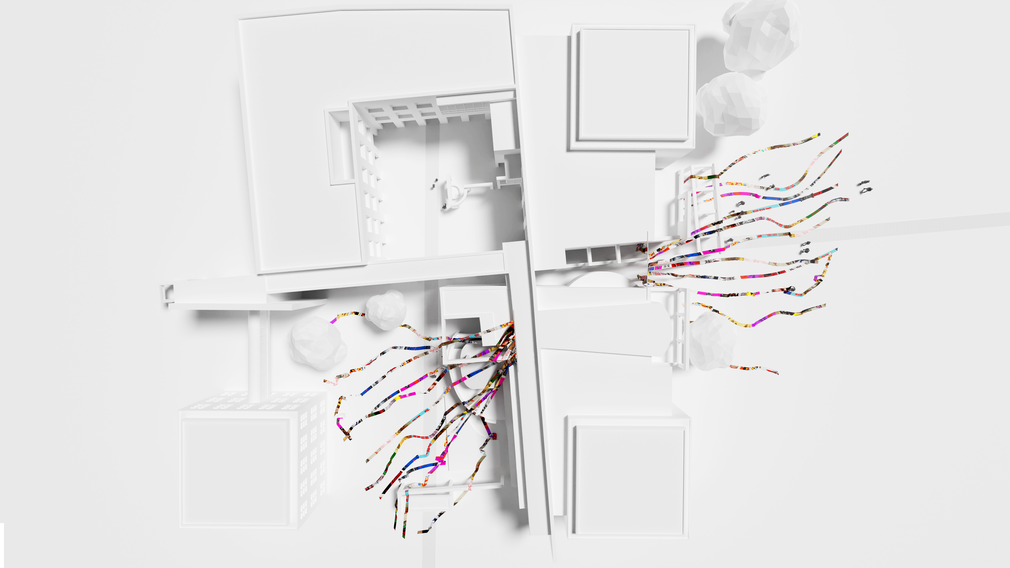
OFBlock - Superblock Offenbach Nordend
The city of Offenbach has set itself climate targets. The 2021-2026 coalition agreement of the ruling traffic light coalition states to "test the establishment of open superblocks (sustainable, traffic-calmed urban neighborhood) on the basis of pilot projects".
The citizens' initiative OFBlock has already taken this as an opportunity to prepare a study on Offenbach's Nordend to test the feasibility of such a project. In cooperation with the citizens' initiative, a superblock concept was developed for Offenbach's Nordend. Based on the reorganization of traffic, modal filters (structural obstacles that influence traffic) were designed, such as bollards. At the same time, design proposals were formulated and tested in virtual reality (VR) to improve the quality of stay in the outdoor space, in the streets. In addition, roadway and path markings play a major role in influencing these new forms of use. Following the seminar, the designs were tested on site, with the involvement of residents. The concepts and designs presented here will be further developed into an overall concept in a next step.
Participants
Lisa Bartz, Lea Bernhard, Till Eser, Emma Kottwitz, Tobias Mendoza, Josephine Pavesi
Supervisors
Prof. Dr. Kai Vöckler
Dipl. Des. Annika Storch
Cooperation
Citizens' initiative OFBlock
Prof. Dr. Jürgen Follmann, Traffic Engineering, University of Applied Sciences Darmstadt
Prof. Peter Eckart, Integrating Design, HfG Offenbach
Year
Summer semester 2022
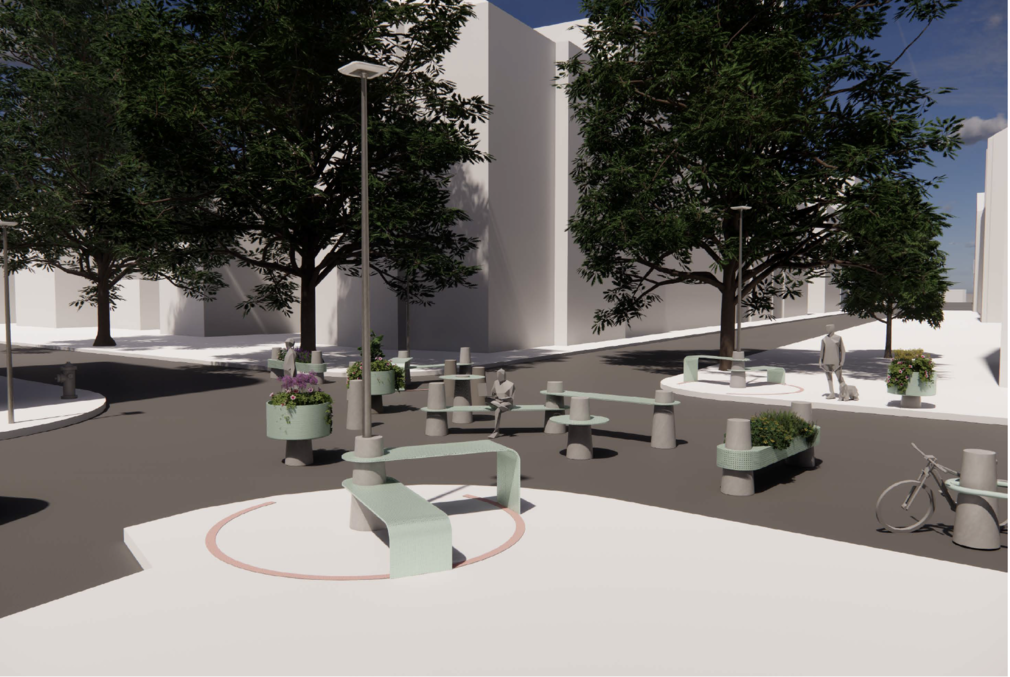
VR simulation of a modal filter. Design: Till Eser
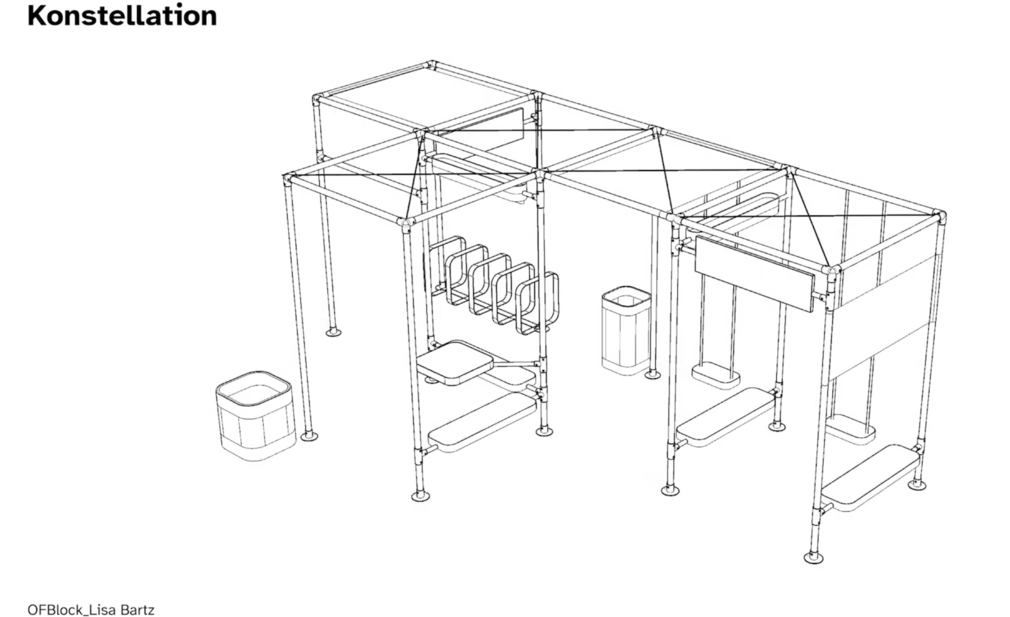
VR-Lab Luisenplatz: Designing mobility in public spaces.
Public spaces create room for people, for movement and encounters. They are open to all and yet at the same time must formulate offers and structure processes. This becomes particularly clear when, in addition to the quality of stay, different mobility offers are bundled in one square. A particularly interesting example of this is the Luisenplatz in Darmstadt, which is not only the central urban square with its high symbolic significance, but also a central linking point for local public transport, but also for pedestrians and cyclists. In the 1990s, Luisenplatz was praised as an example of a public square in which the balance between traffic junction and place to stay was particularly successful. Eight of the total of nine lines of the Darmstadt streetcar meet here. Since then, bus stops have been added and the frequency of buses and streetcars has steadily increased. In a survey conducted by the TU Darmstadt/Department of Architecture on the quality of stay in public spaces in Darmstadt among students, Luisenplatz was rated as the "most stressful place" in 2014. The seminar examined how objects (such as buildings, benches, information pillars), information (writing and pictorial signs, such as line numbers, floor markings) and materialities (surfaces) together form a spatial structure that is strongly characterized by mobility, by moving streetcars and buses, by foot and bicycle traffic - structured by changes in movement, by getting on, off and changing trains, by waiting and moving on. How can orientation be improved by design means, how can information be conveyed, but also how can the quality of stay be improved and stress be reduced?
Participants
Felix Adam, Lea Bernhard, Luis Ganßloser, Noa Haller, Nina Jäcker, Emma Kottwitz, Lukas Kunkel, Clarissa Kurtz, Antoine Ochs, Josephine Pavesi, Carola Schulz
Supervisors
Prof. Dr. Kai Vöckler
Dipl. Des. Julian Schwarze
Cooperation
Prof. Dr.-Ing. Martin Knöll, Urban Design and Planning Unit, TU Darmstadt
Year
Winter semester 2021-2022
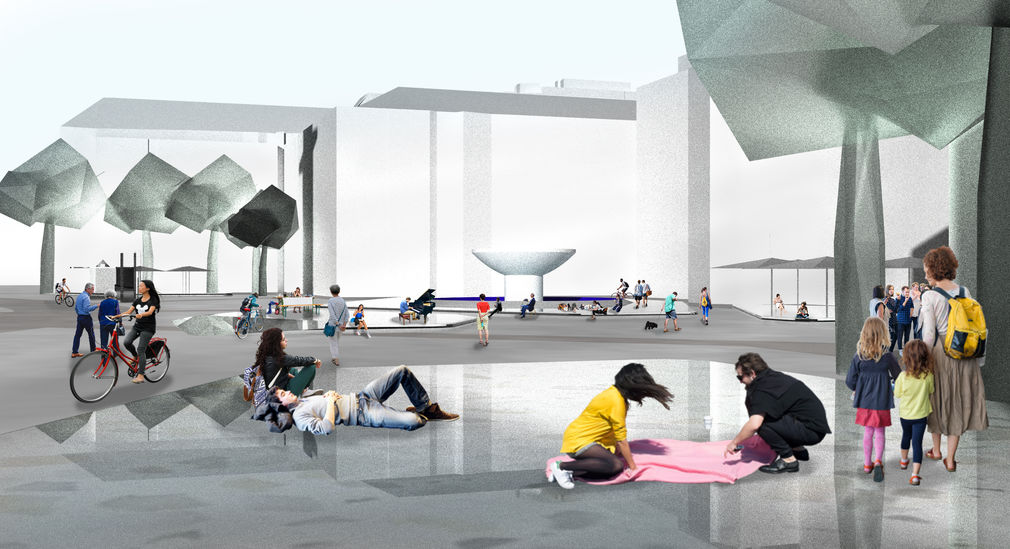
Design concept Luisenplatz: Noa Haller
Mobilität sichtbar machen (“Making Mobility Visible”)
The central problem in the Rhine-Main region, as in Graz and its surrounding area, is the use of private cars (motorized individual transport). In the Rhine-Main conurbation, motor vehicle traffic accounts for the highest proportion of harmful gas emissions, far ahead of aviation, industry and commerce or even buildings. The number of individually used vehicles is growing continuously and overloading the roads. What’s more, transport has contributed nothing to reducing greenhouse gas emissions in the last 20 years. Added to this is the burden on people and the environment from noise, particulate matter, stress and land sealing.
The seminar explored the question: How can the complex correlations of spatial mobility with its effects on people and the environment be visualized so that they become comprehensible (infographics)? Basic information on mobility in Germany and the region as well as the connection between traffic and environmental pollution was explored and visualized.
Workshop in Graz: In an online workshop, the principles developed were adapted to the circumstances in Austria in cooperation with Fabian Walmüller (Stoiser Walmüller Architekten), with a focus on the greater Graz area. The circumstances of mobility in the central area of Graz and the aspects of Graz’s urban development associated with this were visualized. At the end of the workshop, the results were made available to the general public in the form of an exhibition at Club Hybrid. This exhibition also formed the backdrop for a discussion event on the final day of the workshop where experts and politicians gathered to discuss mobility strategies and scenarios for the central area of Graz.
Participants
Amélie Ikas, Leonard Neunzerling
Supervisor
Prof. Dr. Kai Vöckler
Cooperation
Fabian Walmüller, Stoiser Walmüller Architekten Vienna/Graz
Year
Summer semester 2021
Download

Graphic: Leonard Neunzerling
Beweg Dein Quartier (“Move Your District”)
“Beweg Dein Quartier” aims to create more space for people, movement and encounters, boost quality of life, highlight mobility projects and try them out together with local people, bring together those involved, and create impulses for the climate-friendly mobility of the future. The seminar was part of the project “Beweg Dein Quartier” funded by the Federal Ministry for the Environment, Nature Conservation and Nuclear Safety (BMU) (https://bewegdeinquartier.de).
While local people enter into a dialog with urbanista and CURE, developing ideas and trying out visions for the future, students at the Offenbach University of Art and Design took part in a seminar exploring the project area with the aim of finding new solutions. They worked on concepts that shape urban space as a place for coming together, for being mobile and active, for spending time and experiencing new things. We made walking and cycling a priority here, along with connections to public transport. At the same time, ergonomic and barrier-free routes, intuitive orientation and emotional security and wellbeing played a key role.
The overall project was coordinated by the urban development office urbanista, which boasts many years of experience in implementing participatory urban development projects, and the Center for Environmental Management, Resources and Energy (CURE) at the Ruhr University Bochum with experts in participation in climate and infrastructure issues. The City of Offenbach is involved as a partner in practice, while Offenbach University of Art and Design as research partner developed its own standalone contribution to the project with the seminar.
Participants
Jun Jin, Qianyi Cheng, Zhu Zhu
Supervisors
Prof. Dr. Kai Vöckler
Dipl. Des. Janina Albrecht
Cooperation
urbanista, Hamburg
CURE, Essen
City of Offenbach am Main
Year
Summer semester 2021
Download
